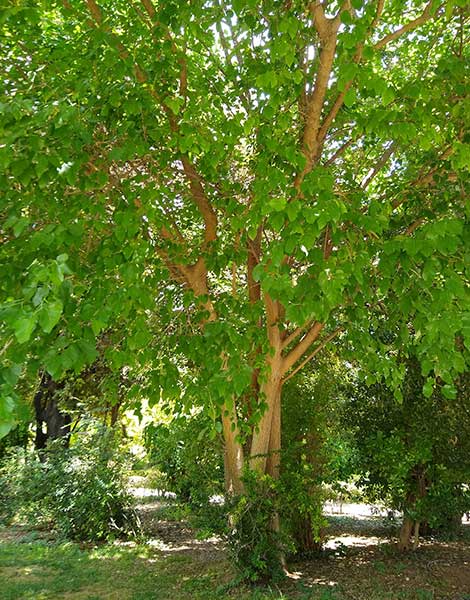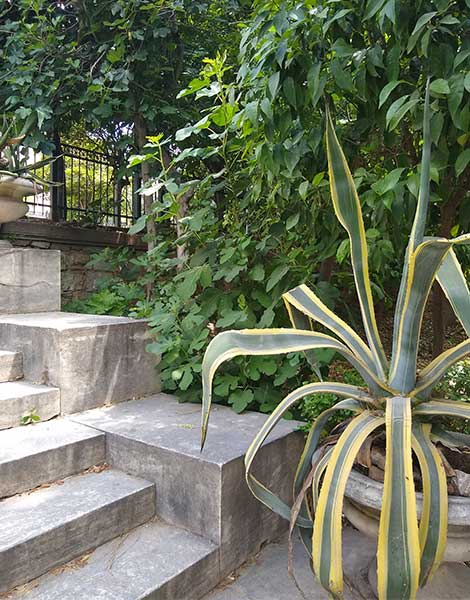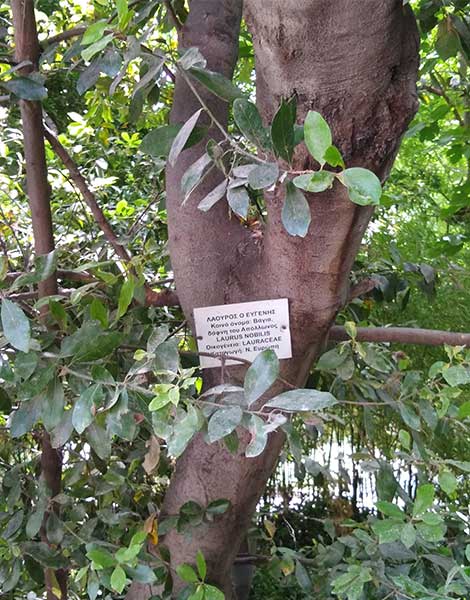Among Greece’s many natural wonders is its biodiversity. With more than 5,500 plant species, of which approximately 760 are endemic, the country is full of herbs, flowers, shrubs and trees associated with certain ancient gods and goddesses and with episodes in their lives. Many of these same plants were used in herbal treatments and in sacred rituals, as well as in the daily cuisine of the ancients, and surviving texts written by philosophers and physicians of that era stress the central role of plants in both spiritual and medical matters. Today, the healing power of these plants remains unchanged, but knowledge of their properties and of the stories linked to them are fading from our collective memory. By exploring their celebrated past, we can keep these tales alive and honor the roles they played in the lives of the ancients.
Fortunately, there’s no reason to leave Athens in search of these timeless plants. Located next to the Parliament building in Syntagma Square, the National Garden, boasting both archaeological remains and tree-shaded areas perfect for picnics, has been an urban oasis for visitors since 1920, when the garden was first opened to the public. This 38-acre treasure was commissioned in 1838 by Queen Amalia, whose name was eventually bestowed on the street now known as Leoforos Amalias, or Amalia Avenue, where the main entrance of the garden is located. While most tourists in Athens seek out ancient marble ruins, whose stories remain locked in time, the historic plants in this garden and throughout the city are as alive and as useful as ever.
While its collection of native plants is most impressive, the National Garden is also home to a variety of non-native plant species. Greeting visitors at the main entrance are a row of magnificent California palm trees (Washingtonia filifera), a non-native species that evokes a tropical feeling even amidst a busy metropolitan area. Stroll further in, however, and you’ll discover a garden full of fascinating plants that feature in Greek mythology and in the medicines of ancient Greece.
Here are five of the most important plants known to antiquity that you should be on the lookout for during your next afternoon stroll:

© Maria Christodoulou

© Maria Christodoulou
1. White Mulberry (Morus alba)
Entering from the main entrance through Leoforos Amalias, walk to the left of the central sundial and you’ll find a young mulberry tree that bears its fruit, white mulberries, during the summer. The mulberry tree was a common sight in ancient Greece and its fruit, leaves, and bark were all used for a variety of medicinal purposes.
The physician and herbalist Dioscorides (40-90 CE) wrote in his five-volume text De Materia Medica that the mulberry fruit was helpful for digestive inflammation and could be boiled and mixed with honey to heal inflamed tonsils. The leaves were used in poultices for burns and a decoction of the outer bark was made to relieve toothaches, kill worms, and as an antidote to the poison in aconite (Aconitum spp.). The tree was featured in Ovid’s poem Metamorphoses; Pyramus and Thisbe are secret lovers, and when Pyramus believes Thisbe to be dead, he kills himself in grief, whereupon she discovers his body and commits suicide as well.
Their blood stains the white mulberries dark red. Now a symbol of the bittersweet nature of love, both white and black mulberry (Morus nigra) trees can be found in the National Garden. Although the fruits of these trees are edible, given the garden’s urban location, their consumption cannot be recommended. Be sure to show this tree some extra love when you visit. Last year, more than a thousand mulberry trees throughout Athens were infested by Xylotrechus chinensis, an invasive wood-boring insect, and many of those trees were lost.
2. Ivy (Hedera helix)
From the mulberry tree, take the second turn on the left and walk until you find the bench on the side of the path. Here, you’ll notice ivy growing up the trunk of some trees and over the ground. This climbing plant was sacred to Dionysus, the god of wine and of drunken festivities. Ancient legend tells us that when Dionysus was born, his nurses wove ivy around his crib as a screen to protect him from his jealous stepmother Hera. Subsequently, the Maenads, the god’s female followers, wrapped ivy around their wands, called thyrsi, which they waved in honor of Dionysus during their wilderness celebrations. Ivy, which symbolizes fertility, affection, and eternal life, was often depicted alongside the god in many ancient Greek and Roman artworks, and was itself revered in sacred contexts.

© Maria Christodoulou

© Maria Christodoulou
3. Fig (Ficus carica)
Continue walking along the same path until you see a set of stairs. Just to the right of the stairs, you’ll find a large fig tree. Figs were a staple of ancient Greek, Roman, and Egyptian cuisine, and were included in countless recipes – from breakfast dishes to desserts to wines. The ancient Greek food writer Archestratus (4th Century BCE) claimed that the best way to cook fresh tuna was to wrap fig leaves around it and bake it under hot ashes.
As a medicine, the fruit was eaten for digestive ailments and the milky sap of the tree was applied to calluses and warts. In the Christian era, both the leaves and the fruit were deeply symbolic; in the Old Testament, Adam and Eve used the leaves to cover their suddenly shameful nudity. The leaves continued to be a symbol of censorship and purity well into the Middle Ages, as evidenced by the Fig Leaf campaign launched by the Catholic Church, which sought to cover nude genitalia on both statues and in paintings, including Michelangelo’s famous David statue. The fruit, on the other hand, symbolized the complete opposite. Given its similar appearance to a drooping part of the male anatomy, figs were an ancient symbol of masculinity and sexual expression. In addition to these opposing meanings, the fig tree was also a symbol of abundance, prosperity, and protection.
4. Bay Laurel (Laurus nobilis)
Continue following the same path until you arrive at the park’s large pond. Located across from the pond, and tucked behind some shrubs, is the most revered plant in ancient Greek mythology. Symbolizing victory, honor, and protection, bay laurel branches were woven into crowns for winners of competitions, including both the Olympics and the Pythian Games; the latter was a competition among poets and musicians held in honor of Apollo, the god of prophesy, music, and poetry.
The ancient story of Apollo and Daphne has been immortalized in countless works of art. Her cry for help to the gods as Apollo pursues her lustfully results in her being transformed into a bay laurel tree, which Apollo then declares should have eternal youth, its leaves never turning brown or falling off. Historians had suggested that, at Apollo’s most sacred temple at Delphi, bay laurel leaves were chewed, burned as incense, or made into tea to induce a trance state for divine communication. However, modern scholarship suggests it was a different type of laurel, one that is poisonous and harmful to human health. Scientific studies have proven that bay laurel is not harmful to health and can help fight colds and fevers and reduce the risk of cardiovascular diseases. The leaves can be also applied externally to relieve arthritic pain and swelling. Although it’s not recommended today, Dioscorides suggested taking “six teaspoons of the root (taken as a drink with sweet wine) to help women during a difficult childbirth.”

© Maria Christodoulou
5. Cypress (Cupressus sempervirens var. horizontalis)
Continue following the path until you reach the impressive 150-year-old Mediterranean cypress tree. In antiquity, this sacred tree symbolized mourning, death, and the underworld. The tree was closely associated with Hades, god of the underworld, and Hecate, goddess of magic, crossroads, and the underworld. Garlands of cypress decorating a home in Athens indicated a grieving family, and cypress wreaths adorned statues of the god to honor the plant’s role in death.
The tree is featured in the Greek myth of Cyparissus, the boy who accidentally killed his favorite deer, a gift from Apollo, and in his unrelenting grief, was transformed into the cypress tree. His tears are forever weeping as the sap of the tree. This is the tree to visit if you’re carrying any grief and need a special place to release it.
*Maria Christodoulou (www.thegreekherbalist.com) is a clinical herbalist exploring the wisdom and whimsy of ancient Greek herbal medicine. She researches and writes about medicinal plants in fantastical myths, ancient scientific writings, and artistic representations that have survived for thousands of years.












